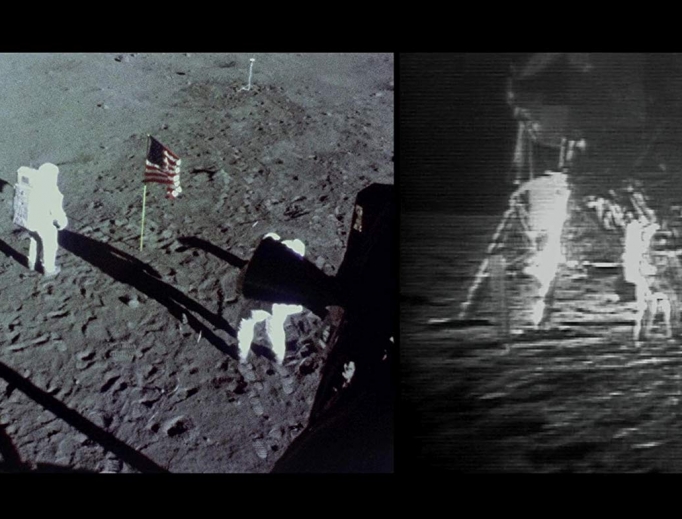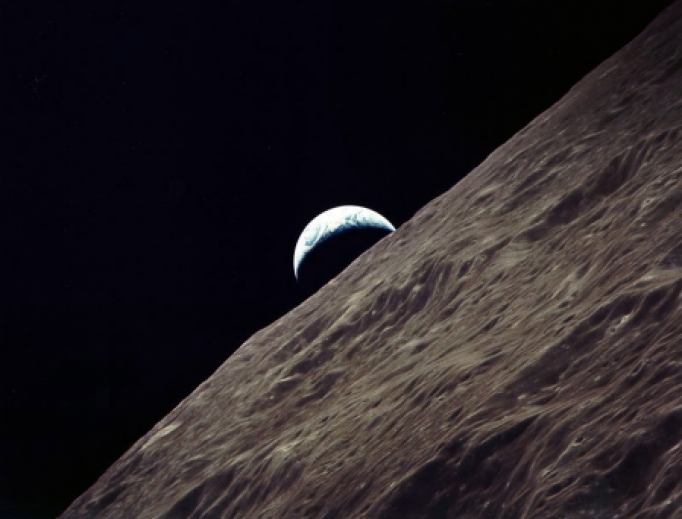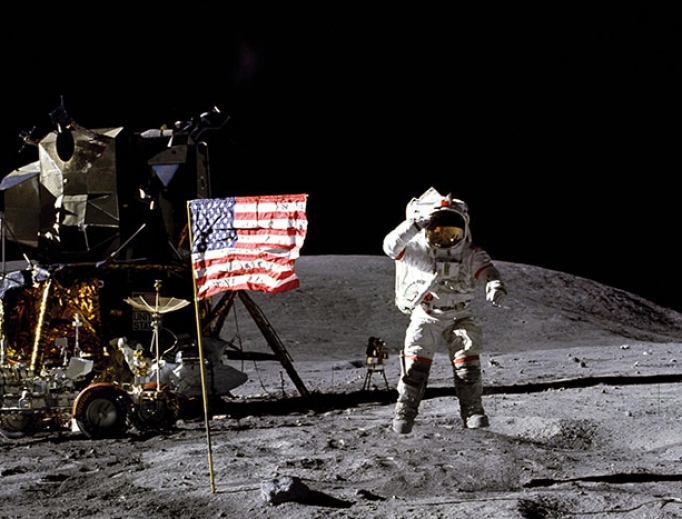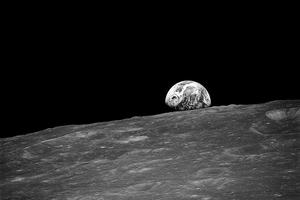‘Conquerors of the Moon’: Documentaries Commemorate the Apollo Project
ON FILM: Celebrate the 50th anniversary of Neil Armstrong and Buzz Aldrin’s historic moonwalk by watching one of a trio of the best documentaries ever made about the Apollo project.

The audacity of the thing was matched only by the unseemly speed of its arrival.
It took humanity thousands of years to go from Icarus and Daedalus and other myths of human flight around the world to the first breathless, fleeting steps into the world of powered, heavier-than-air flight: a pioneering ascent in 1903 lasting less than 15 seconds and rising no more than 10 feet off the ground.
But it took just under 65 years to go from Orville Wright’s historic flight to Neil Armstrong, Buzz Aldrin and Michael Collins strapping into the Apollo 11 command module Columbia atop the Saturn V launch vehicle and preparing for the three-day trip through space that would end with Armstrong and Aldrin walking on the airless surface of the moon.
Competition and geopolitical rivalry helped to fueled the race to the moon, but when those two American men left their footprints in the dust on the lunar surface, they did so on behalf of all mankind. It was a mythic achievement, and, after a mere 50 years, given the brevity of transit between the Earth and our nearest neighbor and the relative closeness to home of subsequent space travel, it has taken on a quality of legend.
Pope St. Paul VI, an avid space-travel enthusiast, spent many evenings watching NASA film footage of the missions that culminated in the Apollo program, obtained for his viewing pleasure by his friend Franco Zeffirelli via a contact at NASA.
“Honor, greetings and blessings to you, conquerors of the moon, pale lamp of our nights and our dreams!” Paul VI exclaimed in his July 21 message to the astronauts on the day after the lunar landing. “Bring to it, with your living presence, the voice of the spirit, the hymn to God, our Creator and our Father.”
The footage that so captivated Paul VI was a tiny fraction of the many thousands of hours of NASA film materials that documentary filmmakers have sorted through over the decades, producing more than a dozen nonfiction films on the Apollo program alone, beginning with the 1969 release Footprints on the Moon.
Of all these films, perhaps the most visually stunning use of that footage is the most recent, the 2019 documentary Apollo 11, directed by Todd Douglas Miller, still in theaters around the country and streaming from Amazon and other services.
A crucial part of what makes Apollo 11 so essential is the rediscovery of a cache of hundreds of neglected large-format film reels, only recently hauled out of the National Archives, containing never-before-seen high-definition images from the mission.

These include breathtaking views of the Saturn V rocket, the immense NASA crawler-transporter carrying the Saturn V rocket into place on giant caterpillar treads, and the throngs of spectators, from celebrities to parents with young children, assembled to witness the launch.
The recovery of these historic images is well served by the purity and sensitivity of Miller’s approach. Apollo 11 is in-the-moment documentary filmmaking, constructed almost entirely of archival footage, without voice-over commentary or talking-head interviews. Only a few explanatory line-drawing animations and onscreen titles offer context on what we’re seeing.
The film’s artistry lies in the curation and construction of visual and audio elements. Often Miller creates diptych, triptych or mosaic split-screen images, highlighting the multifaceted complexity of an endeavor involving hundreds of people working in concert, in which there is never just one thing worth looking at.
The rich sound design includes audio of Walter Cronkite’s live reporting, chatter from scores of Mission Control technicians, period music and a largely ambient synth-driven score created by Matt Morton with the conceit of using only period instruments and effects.
Among conventional talking-head documentaries, perhaps the most memorable is David Sington’s In the Shadow of the Moon (2007), which includes spectacular archival NASA imagery but is distinguished by the reminiscences and insights of 10 of the Apollo astronauts, including Aldrin, Collins and Jim Lovell. (Of then-surviving Apollo astronauts, only the famously reclusive Armstrong, who died five years later, is absent.)
Here, too, filmmaking restraint and discipline are key to the film’s success. The astronauts’ voices are the only ones we hear; there’s no narrator, no interviewer questions.

Awe, humility, humor, anxiety and exhilaration run together as the now-elderly men who traveled to the moon reflect on the cultural and political context of their great project, caught between Vietnam-era shame and guilt, Cold War urgency and Space Age optimism.
Notably, In the Shadow of the Moon reflects on the failures of the Apollo project as well as its successes, from the 1967 Apollo 1 launch-pad fire that killed three astronauts to the ill-fated Apollo 13 mission that could have killed three more.
Perhaps the absence of Armstrong allows In the Shadow of the Moon to give due attention to Collins, who rejects the characterization of his experience orbiting the moon alone as one of unparalleled loneliness (“Not since Adam has any human known such solitude as Mike Collins,” a NASA commentator remarked). Instead, Collins describes his experience as one of “exaltation.”
Other voices go further, evoking the spiritual overtones of journeying in the heavens. One speaks of an experience of unity with the cosmos; another, Charlie Duke, talks about finding God on Earth after returning from space (“My walk on the moon lasted three days; my walk with God lasts forever”).
Finally, splitting the difference between the two approaches, Al Reinert’s 1989 masterful For All Mankind keeps the focus visually on stunning images of the Apollo program missions, but allows the astronauts to speak in voice-over.

Commentary notwithstanding, Reinert’s film, like Apollo 11, is more of a sensory and visceral experience than a traditional documentary, weaving together footage from all six successful Apollo missions into a single cinematic journey, scored by Brian Eno. The astronaut voice-overs contribute to the mood and experience, but Reinert offers no onscreen text identifying the speakers.
“If we fail, it won’t be because of me,” a voice repeats — a mantra traced to an engineer talking to astronaut Ken Mattingly about the one element of the project within his scope of responsibility. The line speaks to the recurring theme of the overwhelming scope of an endeavor too complex for any one person even to fully understand, let alone take responsibility for.
We all know that in a vacuum the effect of gravity on a feather is the same as a hammer; it’s something else to see David Scott actually drop the feather and the hammer together and watch them land on the lunar surface at the same time. As an experiment, it was a foregone conclusion … but the experience goes beyond its experimental significance.
Which is, perhaps, the point of the whole of Project Apollo. Whatever scientific knowledge we brought back from the moon, whatever technological innovations we pioneered to get there, were perhaps secondary to the pursuit of a kind of transcendence. However brief our stay, that “pale lamp of our nights and our dreams” is now a human world, touched by “the voice of the spirit.”
I suppose few would have predicted when the Apollo program came to an end in 1972 that a half-century after men walked on the moon the human race would have stayed thereafter so close to home. Mars continues to beckon, and it seems NASA may finally be rising to the challenge.
It’s possible, of course, to cross-examine the whole enterprise of space travel. Robots and probes can tell us all we need to know about distant worlds without the difficulty, danger and expense of transporting fragile human beings there and back.
Meanwhile, terrestrial crises both perennial and modern — violence and war, environmental challenges, poverty and hunger — demand our attention.
A theme running through all the Apollo documentaries is the idea that this American endeavor in some way fostered a sense of global unity. The moon landing wasn’t just an American achievement, but a human achievement.
Could a renewed space program contribute in some way to greater human unity? If we do go to Mars, what will we find there? Perhaps more importantly, what will we bring to it?
Steven D. Greydanus is a permanent deacon for the Archdiocese of Newark, New Jersey,
and the Register’s film critic.
















